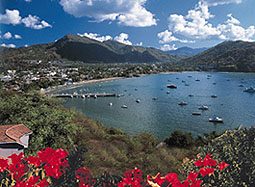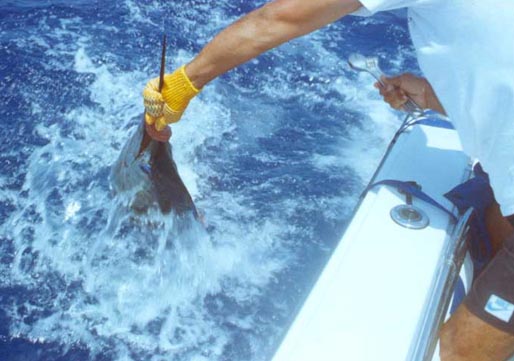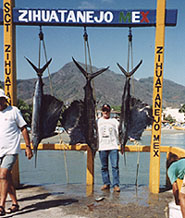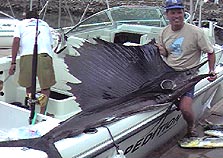The Pacific Sailfish is one of the most exotic game fish found in the world. Larger than it's near identical Atlantic cousin, they share the same characteristics of iridescent colors and a magnificent sail for a dorsal fin. Spectacular is the only word to describe the leaps and aerobatics the angler experiences when hooked up with one of these noble fish. To have the ability to catch a sailfish, day in and day out for an entire year, would be considered heaven by many a fisherman.
 |
Ixtapa / Zihuatanejo is located roughly half way between Cabo San Lucas and the Guatemalan border on the Pacific Coast side of Mexico. The two towns are three miles apart, divided by a |
large peninsula, and about 135 miles north of Acapulco. Ixtapa was originally developed in 1975 by FONATUR, the Mexican Department of Tourism, as a complementing twin city concept. The area has blossomed into a destination that appeals to not just fishermen, but to all people and all lifestyles as a premier vacation spot with Zihuatanejo (called Z-watt by the locals) retaining its Old Mexico charm and Ixtapa becoming a world class resort.
As a resident expatriate, I am continually amazed as to the quality of the fishing, the warmth and generosity of the Mexican people, and the incredible paradise that defines Ixtapa / Zihuatanejo.
I have been asked many times which is the best month to catch a sailfish in these waters. My answer is always the same: "year round". Granted, in February and March we really get a mass migration on this coast with 13 to 15 releases a day not uncommon, but (as I am writing this) it is now July and the fishing is outstanding. We are under a full moon and had 5 releases three days ago with two releases and 10 school size yellowfin tuna yesterday. It will even get better as the moon wanes in its cycle.
 |
Here, we need not cover a lot of water to find the sailfish, so, artificial lures trolled at higher speeds are not often used. The methods we use for catching sailfish are |
essentially the same for everybody on this coast. It does not matter if you are in an open panga with a 48hp Yamaha outboard, on my center console with full electronics, or a 50 foot private yacht. We all fish primarily with a dead trolled bait called a "split tail". To get our bait we either use our own cast net or purchase the 6 to 8 inch long goggle eyes or 10 to 12 inch mullet (called ojotones and lisas) from the local fishermen. The Zihuatanejo Bay has an incredible year round supply of bait and it is never a problem to obtain it.
The bait fish are first gilled and cleaned, then cut from the vent, up to and behind the dorsal fin. Then (like you are going to fillet the back half of a fish) traverse the knife along the backbone and all the way through the fish, including the tail. It takes a good sharp knife and a little practice to get the tail to split into two matched sections, but, once it is done and you break the back bone behind the dorsal fin, you have a bait that gives a lot of action in the water.
We then match the size hook to the bait and sew it on in a normal manner that ensures it to not spin at troll speeds of 4 to 6.5 knots, and either add a chin weight or run a light sliding sinker ahead of the hook on the nine to 12 foot long 100 pound leader.
In order to cover all the options, I use a downrigger, two outriggers and two flatlines on my Cabo for a total of 5 rods. Blue and black marlin are a definite possibility. We start trolling right outside the bay with a Rapala or a hootchie to pick up a couple of two to three pound barriletes (similar to a bonito) and put them in the tuna tubes. Once we get out in the blue water or about six miles, we drop down another downrigger and a sixth rod for the barrilete on a standard live bait harness with the hook riding free in front of the eyes.
The catch and release concept has been slow in coming to Mexico. There has been a definite improvement because knowledgeable clients are beginning to demand it. Even though the sailfish is not considered to be good table fare, the idea of releasing "food" in a poor country is very hard to overcome. I have had a gas station attendant just stare at me in disbelief when I told him we released 5 sailfish that day. He was thinking that a single fish would feed his family for a week and that I was surely one crazy Gringo.
 |
One of the problems with the "split tail" setup is that the sailfish will swallow the bait and at least 2 out of 5 fish are injured so deeply that a release is not possible. We are overcoming that problem with a gradual acceptance of the use of circle hooks. I have had more than one captain tell me |
that it is impossible to catch fish with a hook that curves in. Some say they do not even want them on their boat. It is a learning experience that I have had to insist on with my deckhands and then teach them to sew a bait and use a hook setting method different than their grandfathers taught them.
Ixtapa / Zihuatanejo has an unusual situation in that we do not really have an early morning bite. The majority of the sailfish are caught between 9:30 AM and 1:00 PM. I have pondered this and noted that, in the morning as we head out to the fishing grounds, the bait fish showing on my meter are always below 150 feet. They are located at the same depth, along a horizontal line that remains constant, each time we run across a new concentration. Our water surface temperature averages about 80º year round. I believe the bait are sitting just above the thermocline. As the sun gets higher, the bait fish seem to come out of the depths to feed and disperse throughout the water column. If I am not metering bait, I get out of the area. When I start metering the bait at different depths, we start getting action on our game fish.
How good is the fishing here? Ray Romanin and a group of friends from Colorado were here this last February 7, taking advantage of the 80º weather and fine amenities of one of the hotels in Ixtapa. He contacted me and wanted to fish a half day- then go to Ixtapa Island to snorkel in the ecological preserve and sip a couple of cold ones while kicking back under the shade of a palapa for the rest of the day. We left at daybreak and I told them not to expect much for a couple of more hours. By 10:15 we had worked our way from Zihuatanejo Bay to 6 miles out in front of Ixtapa Marina and they began to wonder where the fish were. I knew we were approaching a good drop-off and I said to give it another 5 minutes because, on the meter, I also saw the bait fish were dispersing. At the 5 minute mark, we had all 5 rods go down and five sailfish bouncing around behind the back of the boat. Till things got settled down, we had a bit of excitement for a while because there were 4 non-experienced clients, the deck hand and me.
We got to the island by noon and had a great lunch on a fresh dorado we caught while fast trolling to the island. I still have not convinced Ray's wife that I did not have those fish tied off on a buoy in 1200 feet of water and they were just waiting for us to show up.
Ray came back with his family on March 24 giving me a charter captain's worse nightmare by saying he wanted a repeat performance. At about 8 miles the downrigger went off and while my deck hand was reeling in an outrigger line, he got bit also. I then grabbed a flat line rod to help get the baits in while the deck hand set the hook and handed his rod off. I was about to reach out for the swivel and bring the "split tail" in the boat when a sailfish came up on the corner with his mouth wide open. I just free spooled the reel which dropped the bait down his throat and when he turned, I let the circle hook do the rest. Three nice sailfish and another great day at the island.
How big are these Pacific sailfish? While fishing with Paul and Karen Sherwood on June 6, we had to run back to the marina to unload a seasick friend of theirs. We were right at the prime time, and we were spotting fish when I got the request to return. After getting a taxi for the guest, we ran back out to the same spot. Paul got a sail that taped out at over 9 feet long and about 105 pounds. We then trolled for another 1/2 hour and less than a mile away, Karen got her sailfish that taped out 1 inch shorter and just a couple of pounds less. Most fish here run about 65 to 85 pounds and even though these two fish were considered to be "tournament" size fish, it is not unusual for us to release one or two a week that run between 90 and 100 pounds.
Several times a year the blue water current is just off the beach, and the game fish come with the water. The Roca Solitaria is a small pinnacle that rises up out of 165 feet of water and is located about 1/2 mile in front of Zihuatanejo Bay. Many a time we have hooked sailfish within 100 feet of this rock while fishing for other inshore species. At times they can become a nuisance because our leaders are too short and not heavy enough for the coarse beak of the sailfish and the inevitable cut-off happens after the first couple of spectacular leaps.
 |
Sailfish are the mainstay of the sport fishing industry here in Ixtapa / Zihuatanejo but it is by no means the only fishery. From December through June we have the giant |
yellowfin tuna and blue marlin. School size tuna and dorado are here year round. Sometimes we have to travel a little further for the tuna or marlin. However, on the average, when targeting the species, you will get a 250 pound plus blue marlin or a 200 pound plus yellowfin tuna for every three days on the water.
Karl Peters lives in Nashville but manages to get down here for about 3 months of the year. He has become somewhat of an expert on fishing the blue marlin in these waters by fast trolling large artificials only. In December of this last year he fished 8 days, raised 12 blue marlin and released 8 for an average of one a day. Karl fishes the areas around the 1000 fathom curve and all of his marlin were about 25 to 32 miles from the lighthouse out of Zihuatanejo Bay.
The inshore fishery here can be outstanding at certain times of the year, however we do not have to wait for the blue water to move in close to get some fantastic light line fishing. The roosterfish action is exceptional and are taken just off the surf line, along our miles of pristine coconut palm lined beaches. By going out a little further and following the crashing birds, we find the hard fighting jack crevalle that average about 15 pounds with 25 pounders not being uncommon.
If you want the thrill of catching sailfish while vacationing in a place that is a paradise for the whole family, come enjoy the laid back lifestyle of Old Mexico. Experience Ixtapa / Zihuatanejo for a week or so and get a taste of what we have all year long.
To get here: Ixtapa / Zihuatanejo has an International Airport with daily direct flights from L.A. and Houston. There are many other flights here from other cities throughout the U.S. and Canada, making a short layover in Mexico City. Apple Vacations and a few other agencies put together charter flights that fly in direct from many cities from the U.S. Heartland.
Ed Kunze
Owner of the Experiencia Mar y Tierra sportfishing charter fleet in Ixtapa/Zihuatanejo, Ed Kunze knows more than a little about living in paradise and a lot about fishing for sailfish and other species. You can e-mail Ed at ixtapa@travel.com.mx.
Do you have a unique story about Mexico, it's history, culture or your own travels that our readers might enjoy here on Mexonline.com? If so we'd be happy to read it and consider it for inclusion into our Feature Stories section. Just take a look at our writer's guidelines for more information and how to send us your story. Let's hear from you!
|